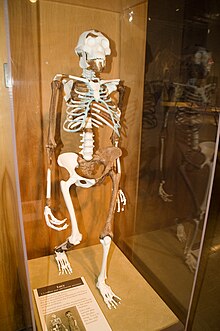Cleveland Museum of Natural History
 | |
 | |
| Established | 1920 |
|---|---|
| Location | 1 Wade Oval Drive Cleveland, Ohio 44106 USA |
| Coordinates | 41°30′41.6″N 81°36′47.1″W / 41.511556°N 81.613083°WCoordinates: 41°30′41.6″N 81°36′47.1″W / 41.511556°N 81.613083°W |
| Visitors | 260,000[1] |
| President | Sonia Winner [2] |
| Website | www |

The Cleveland Museum of Natural History is a natural history museum located approximately five miles (8 km) east of downtown Cleveland, Ohio in University Circle, a 550-acre (220 ha) concentration of educational, cultural and medical institutions. The museum was established in 1920 by Cyrus S. Eaton to perform research, education and development of collections in the fields of anthropology, archaeology, astronomy, botany, geology, paleontology, wildlife biology, and zoology.[3] The museum traces its roots to the Ark, formed in 1836 on Cleveland's Public Square by William Case, the Academy of Natural Science formed by William Case and Jared Potter Kirtland, and the Kirtland Society of Natural History, founded in 1869 and reinvigorated in 1922 by the trustees of the Cleveland Museum of Natural History.[4]
Donald Johanson was the curator of the museum when he discovered "Lucy," the skeletal remains of the ancient hominid Australopithecus afarensis. The current Curator and Head of the Physical Anthropology Department is Yohannes Haile-Selassie.
In 2002, the new Fannye Shafran Planetarium was built near the entrance to the museum, containing displays on the planets in the Solar System, and historical instruments of exploration, such as compasses and astrolabes.
Exhibits[]

Museum collections total more than four million specimens and include specimens of paleontology, zoology, archaeology, mineralogy, ornithology, and a variety of other scientific subjects.
A beloved full-scale model of a Stegosaurus on the lawn delights Cleveland children.
Some of the more important specimens are:
- An extensive collection of Late Devonian fossil fish from the Cleveland Shale, including several mounted skulls of the arthrodire placoderm Dunkleosteus.
- Nine hundred monkey and ape skeletons, and more than 3,100 human skeletons (the Hamann-Todd Collection).
- The only specimen of the small tyrannosaur Nanotyrannus lancensis.
- The holotype of the Haplocanthosaurus sauropod.
- The most complete mount of a Coelophysis bauri.
- Mounted taxidermy remains of Balto the sled dog.
- An extensive mineralogy collection that includes a Moon rock and the Jeptha Wade gem collection.
- Replica skeletons of Triceratops and Jane, a juvenile tyrannosaurid.
- Multiple mastodon and mammoth specimens.
- A cast of an Australopithecus afarensis skeleton, an early hominid affectionately dubbed Lucy.
- A new Tyrannosaurus skeleton that is now on display.
- The museum's Allosaurus has been remounted and is on display.
- A collection of 30,000 plant fossils acquired from the University of Cincinnati by former curator of paleobotany, Shya Chitaley.[5]
- A Foucault pendulum underneath in which the Bicentennial Education Time Capsule was buried in 1996 and will be opened in 2046.[6]
The museum has made many discoveries over the years. Recently, in Vertebrate Paleontology, both the remains of a Titanichthys[citation needed] in Ohio and a new ceratopsian, Albertaceratops nesmoi, have been made. Both are expected to go on display eventually.
Hamann-Todd Collection[]
The Hamann-Todd Collection is a collection of more than 3100 human skeletons and over 900 primate skeletons that were assembled starting in 1893. The collection was originally housed at Western Reserve University Medical School in a new medical building that was built for that purpose. The first floor of this building contained the Hamann Museum of Comparative Anthropology and Anatomy. However, due to the costs of storing the bones, the collection was transferred[when?] to the Cleveland Museum of Natural History.[citation needed]
In 1893, Carl August Hamann initiated the collection. Its administration was taken over by T. Wingate Todd after Hamann was named dean of Western Reserve University's medical school in 1912. Todd managed to assemble the great majority of the human skeletons in the collection, over 3000, before his death in 1938.[citation needed]
Perkins Wildlife Center[]
The Ralph Perkins II Wildlife Center and Woods Garden presented by Key Bank, which includes live animals and plants native to Ohio, opened on September 3, 2016.[7][8]
References[]
- ^ https://www.cmnh.org/CMNH/media/CMNH_Media/CentennialMedia/docs/CMNH_AtAGlance_final.pdf
- ^ Steven Litt, The Plain Dealer (July 27, 2018). "Cleveland Museum of Natural History promotes Sonia Winner from acting CEO to president and CEO". cleveland.com. Retrieved 2019-01-09.
- ^ Cyrus Eaton - Cleveland Biography
- ^ Hendrickson, Walter B. (1962). The Arkites and Other Pioneer Natural History Organizations of Cleveland. Cleveland: Western Reserve University. LCCN 62-17763.
- ^ Segall, Grant (10 May 2013). "Researcher Shyamala Chitaely worked until nearly age 93 at the Cleveland Museum of Natural History: News obituary". The Plain Dealer. Retrieved 11 June 2013.
- ^ "Archived copy". Archived from the original on 2015-10-01. Retrieved 2015-09-30.CS1 maint: archived copy as title (link)
- ^ Litt, Steven (28 August 2016). "Cleveland Museum of Natural History's new Perkins Wildlife Center: The best 2 acres in CLE". The Plain Dealer. Retrieved 28 August 2016.
- ^ "Perkins Wildlife Center". Cleveland Museum of Natural History. Archived from the original on 26 April 2016. Retrieved 28 August 2016.
- Jones-Kern, Kevin; Bruce Latimer (Spring 1996). "Skeletons Out of the Closet". Explorer. Retrieved 2006-07-09.
External links[]
| Wikimedia Commons has media related to Cleveland Museum of Natural History. |
- Museums in Cleveland
- Natural history museums in Ohio
- University Circle
- Museums established in 1920
- Planetaria in the United States
- 1920 establishments in Ohio
- Institutions accredited by the American Alliance of Museums
- Dinosaur museums in the United States
- Paleontology in Ohio

